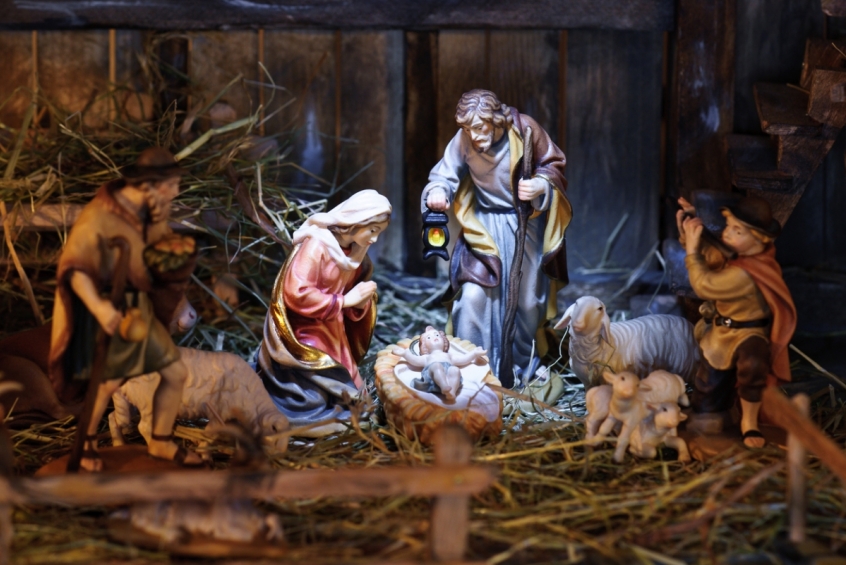
The Christmas Nativity story as we know it is formed by harmonising two different accounts from the New Testament. This is the story ...
The original story
Many of the modern ideas of the Nativity in the popular mind are not actually found in the Bible at all, but are supplied by images from famous paintings, Christmas cards, words from Christmas carols, images from crib scenes, and scenes from Nativity plays. These are so well rehearsed annually, that people can be forgiven for thinking that they know what the actual Christmas story is, without reading the Bible. However, for convenience these contract and conflate events, which took place over a period of time, and add in assumed or traditional details and features to embellish the original story. For the original account, we need to go back to the Scriptures.
The birth of the Messiah in prophecy
Jesus does not appear explicitly by name in the Hebrew Bible, which forms the Christian Old Testament. However, there were many prophecies of the coming Messiah. These were not a coherent set of Messiah prophecies, but rather clues and glimpses of the future. Opinion varied, and still varies, as to which passages in the Hebrew Scriptures are messianic prophecies and which are not.
Jewish scholars pieced these together and foresaw details about the coming Messiah. Jewish scholars at the time of Jesus generally agreed that the Messiah would be a man from the tribe of Judah (Genesis 49:10), who was a descendant of Jesse (Isaiah 11:1-10) in the line of King David (2 Samuel 7:12–13), born in David's town called Bethlehem (Micah 5:2), and be preceded by a prophet in the style of Elijah (Isaiah 40:3, Malachi 4:5-6). Some also believed that the Messiah would be born of a virgin (Isaiah 7:14 NIV), and be preceded by a special star (Numbers 24:17).
Accounts of Jesus in the Bible
There is no single definitive account of the birth of Jesus in the Bible. The accounts of the life of Jesus appear in the first four books of the New Testament. These are known as the Gospels. Actually, there is only one "gospel" in the true sense of the word. What we have are four accounts of "The Gospel According to" Matthew, Mark, Luke and John which were written by, or attributed to, the names given to the books. These books take the life of Jesus through from the start of his ministry and up to his death and crucifixion, and in the case of Mark and Luke end with his ascension. The story of the Early Church is then continued in the book of the Acts of the Apostles.
Accounts of the birth of Jesus
It is only in the two Gospel accounts according to Matthew and Luke that we read about the birth of Jesus. Mark and John start the story of Jesus at his baptism by John the Baptist. All four of the Gospel accounts record the death and resurrection, which was the most important message to tell, and more important than relating his birth.
The birth narratives
The narratives related to the birth of Jesus are only found in the first two chapters of Matthew and the first two chapters of Luke. Many of the events told in the Gospel accounts, especially in the Synoptic Gospels of Matthew, Mark and Luke are similar. Some stories are retold in different Gospel accounts, but what is interesting about Matthew and Luke, is that they each tell unique aspects of the story of Jesus's birth not repeated anywhere else. The biblical Christmas story as we know it, is actually a harmonised story formed from dovetailing the narratives from Matthew and Luke.
The common story
Although different, Matthew and Luke share a common set of key events. Both narratives tell about a Jewish virgin called Mary, who was betrothed to be married to a man called Joseph (Matthew 1:18, Luke 1:27), who was from the royal dynasty descended from King David (Matthew 1:20, Luke 1:27). Both of the narratives explain that Mary conceived by the Holy Spirit (Matthew 1:18, Luke 1:35), and that the name Jesus was given by an angel (Matthew 1:21, Luke 2:21).
Both Matthew and Luke explain that Jesus was born in Bethlehem (Matthew 2:1, Luke 2:4-7) and then grew up in Nazareth (Matthew 2:23, Luke 2:39-40). They both explain these events happened during the reign of King Herod (Matthew 2:1, Luke 1:5). All the other events associated with the Nativity are found uniquely in either Matthew or Luke.
The different parts of the narrative
It is Luke who mentions the angel who appeared to Mary, and her subsequent visit to Elizabeth, mother of John the Baptist (Luke 1:26-56). We then have to go to Matthew to learn that Joseph wanted to call off the wedding, and changed his mind after a dream (Matthew 1:18-24). It is Luke, who mentions the whole account of the census, travelling to Bethlehem, and the story of the shepherds (Luke 2:1-20). It is also Luke who mentions the Jewish ceremonies: of circumcision 8 days after the birth, and purification 40 days after the birth, when Mary and Joseph met Simeon and Anna (Luke 2:21-38). We then have to go to Matthew for the story of the wise men, the exile in Egypt, and the slaughter of the innocents at Bethlehem by the paranoid King Herod (Matthew 2:1-18). Luke then uniquely tells us about Jesus at the Temple when he was twelve (Luke 2:41-52). Matthew and Luke then both plunge into the story of John the Baptist.
Different narratives
The reason why Matthew and Luke differ may be because they used different sources for their information, although both seem to have used a previous Gospel account by Mark. Scholars over the centuries have concluded that Matthew was written for Jewish readers, whilst Luke was written for the Gentiles, and so this frames the accounts that are told. The Gospel of Matthew has the largest number of messianic quotations from the Old Testament, which would have been relevant for a Jew anxiously wanting proof that Jesus was the Messiah, but would have been of less interest to a Gentile.
Christmas canticles in liturgy
Also unique to Luke's Christmas narrative are songs known as the Christmas Canticles. It is in Luke that we find the song of Mary, known as the Magnificat (Luke 1:46-55), the song of Zechariah, known as the Benedictus (Luke 1:68-79), the song of the angels, known as the Gloria in Excelsis (Luke 2:14), and the song of Simeon, known as the Nunc Dimittis (Luke 2:29-32). The singing of these canticles has been a part of Christian worship for centuries. They remain an important part of the liturgical traditions in Orthodox, Catholic, Lutheran and High Anglican traditions, but are not so well known in evangelical churches.
What the Bible does not say
Many of the modern ideas of Christmas are from tradition and etched into our minds by images, songs and plays. We imagine Mary and Joseph travelling to Bethlehem by donkey, battling the snow to find somewhere to stay, and then being disturbed by shepherds and three wise man coming on camels.
Although Mary and Joseph are usually illustrated travelling to Bethlehem by donkey, the Bible does not indicate how they travelled to Bethlehem. They may have used a donkey, or they may have walked. The text does not say.
In the Western tradition, Christmas is marked on 25th December, but the Bible account does not state the actual date that Jesus was born on, nor even the year, nor the time of year. We only know it was near the end of King Herod's reign (Matthew 2:9). The Bible does not say what the weather was. It almost certainly was not snowing, and it might not have been winter.
Nativity plays feature three wise men, but the Bible does not state how many there were, and does not call them kings, and it does not mention which mode of transport they used. There may have been three of them or many more. The text does not say - it is just in plural (Matthew 2:1). They may have may used camels, or they may have walked. The text does not say.
Although Nativity scenes generally show shepherds and wise men all visiting the manger in the same evening, the biblical narrative has them happening at different times and different places. Creating a Nativity play for a school or church admittedly requires some poetical licence to combine events. The Bible does not say when the wise men arrived, except they arrived to visit the child at a house (Matthew 2:11), which seems to be some time after the birth.
Traditional crib scene
The traditional image of the crib scene is not even based on the biblical account, but based upon a reputed vision by a Swedish mystic called Birgitta Birgersdotter (1303-1373). Birgitta devoted herself to a life of prayer and caring for the poor and the sick. From childhood she is said to have had visions which were written down. Shortly before she died she had a reputed vision of the Nativity, in which she described the infant Jesus lying on clean swaddling clothes on the ground, and emitting a divine light, with a blond-haired Mary knelt in prayer beside him. Birgitta died in Rome in 1373, and was canonised with the name St Bridget of Sweden in 1391. Accounts of her visions were written down as Revelationes coelestes. They were very popular in medieval Europe and influenced paintings and tapestries which depicted biblical scenes as she described them. Many depictions of the Nativity followed this scene, and added an ox and a donkey.
Read the original story
For the real story of Christmas, don't rely on the traditional images. Get a Bible and read the first two chapters of Matthew and Luke, or listen to them in audio. You maybe surprised by what it does, or even does not say.
Neil Rees is a publishing consultant, historian, freelance writer and speaker. He is also involved in youth work at his local village church, and guest preaching in churches of different denominations.













